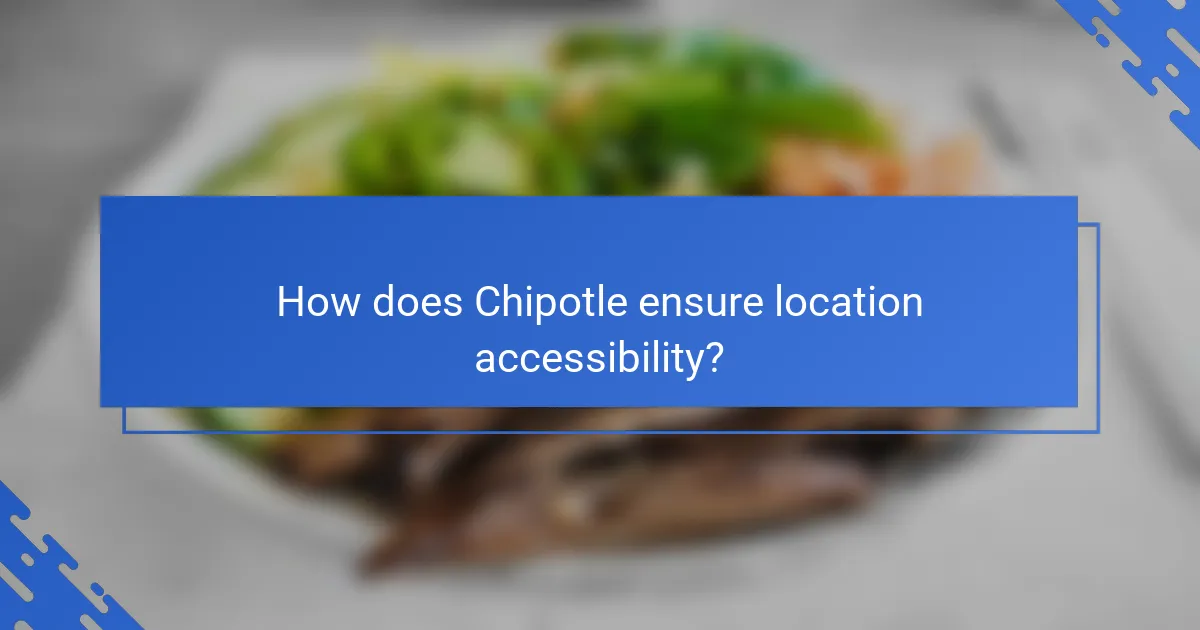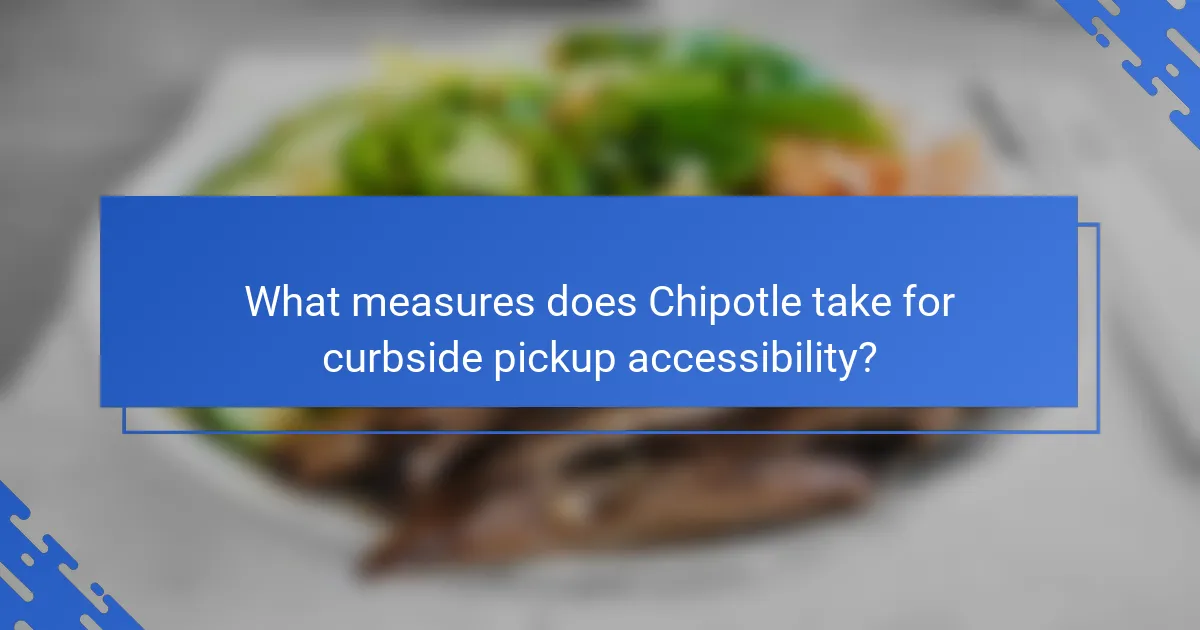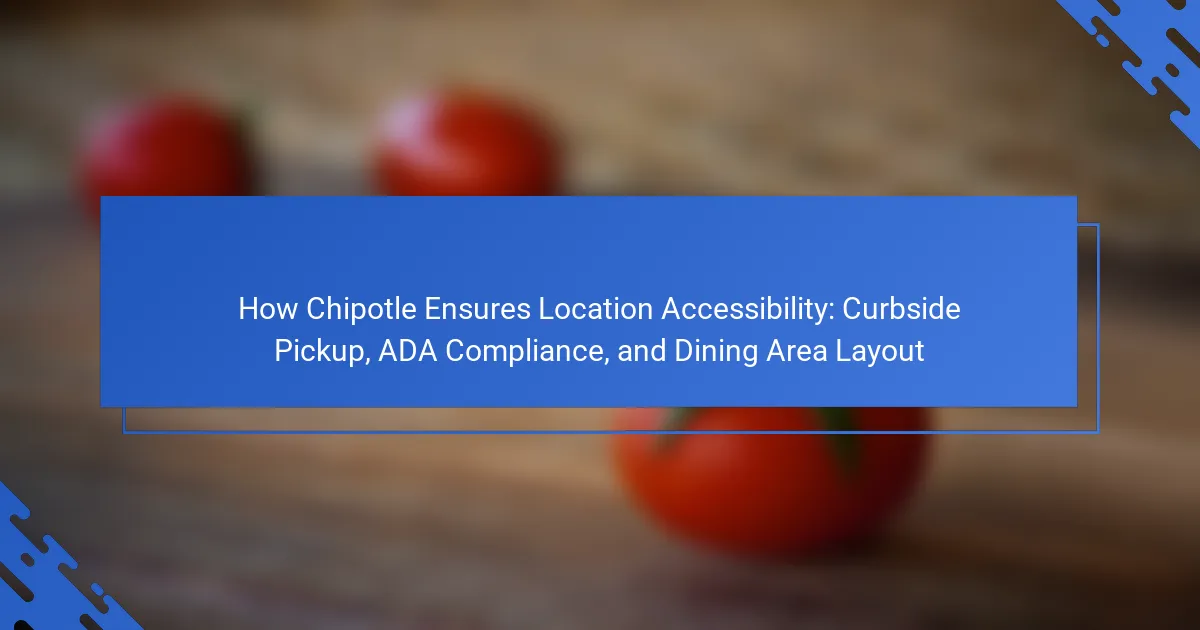Chipotle is a fast-casual restaurant chain focused on enhancing accessibility for all customers. The article outlines Chipotle’s strategies for ensuring location accessibility, including curbside pickup options that allow customers to order ahead and receive meals without entering the restaurant. It discusses compliance with the Americans with Disabilities Act (ADA), highlighting features like ramps, designated parking spaces, and well-designed dining areas that accommodate individuals with disabilities. Additionally, the article details how Chipotle’s staff is trained to assist customers with disabilities and the ongoing review processes in place to maintain ADA compliance. These initiatives collectively demonstrate Chipotle’s commitment to accessibility for a diverse customer base.

How does Chipotle ensure location accessibility?
Chipotle ensures location accessibility through various strategies. They implement curbside pickup options for customer convenience. This allows patrons to order ahead and receive their meals without entering the restaurant. Additionally, Chipotle complies with the Americans with Disabilities Act (ADA). This compliance ensures that their locations are accessible to individuals with disabilities. They provide features such as ramps and designated parking spaces. Furthermore, Chipotle designs dining areas to accommodate all customers. This includes sufficient space for mobility devices. Collectively, these efforts enhance overall accessibility for diverse customer needs.
What are the key components of Chipotle’s accessibility strategy?
Chipotle’s accessibility strategy includes curbside pickup, ADA compliance, and inclusive dining area layout. Curbside pickup allows customers to easily collect orders from their vehicles. ADA compliance ensures that all locations meet legal accessibility standards. This includes wheelchair ramps and accessible restrooms. The dining area layout is designed to accommodate all guests, including those with mobility challenges. Chipotle also trains staff to assist customers with special needs. These components collectively enhance the overall customer experience.
How does curbside pickup enhance accessibility for customers?
Curbside pickup enhances accessibility for customers by providing a convenient option for those with mobility challenges. It allows individuals to place orders online and receive them without entering the store. This service reduces physical strain and time spent navigating potentially crowded or inaccessible spaces. According to a study by the National Restaurant Association, 60% of consumers prefer curbside pickup for its convenience. Additionally, curbside pickup supports social distancing, which is crucial for health and safety. By implementing this service, businesses like Chipotle cater to a wider range of customer needs, ensuring inclusivity.
What role does ADA compliance play in Chipotle’s locations?
ADA compliance ensures that Chipotle’s locations are accessible to individuals with disabilities. This compliance includes features like wheelchair ramps, accessible restrooms, and designated parking spaces. The Americans with Disabilities Act (ADA) mandates these standards for public accommodations. Chipotle aims to create an inclusive environment for all customers. Compliance with ADA regulations helps avoid potential legal issues. It also enhances the brand’s reputation by demonstrating a commitment to accessibility. By adhering to these guidelines, Chipotle improves the overall customer experience.
Why is dining area layout important for accessibility?
Dining area layout is crucial for accessibility because it ensures all patrons can navigate the space comfortably. An accessible layout accommodates individuals with mobility challenges, including those using wheelchairs or walkers. Clear pathways and appropriately spaced tables allow for easy movement. According to the Americans with Disabilities Act (ADA), establishments must provide accessible routes and seating. Non-compliance can lead to legal repercussions and alienate potential customers. Therefore, thoughtful dining area design enhances both usability and customer satisfaction.
What design features promote accessibility in Chipotle’s dining areas?
Chipotle promotes accessibility in its dining areas through several key design features. These include wide pathways for easy navigation. The seating arrangements often include accessible tables for wheelchair users. Additionally, Chipotle locations typically have ramps for entry and exit. The restaurant also ensures that service counters are within reach for all customers. Visual and auditory signage aids in navigation for those with sensory impairments. Furthermore, the layout is designed to minimize obstacles and provide clear sightlines. These features collectively enhance the dining experience for individuals with disabilities.
How does seating arrangement affect customer experience?
Seating arrangement significantly affects customer experience by influencing comfort, interaction, and service efficiency. A well-planned layout can enhance social interaction among diners. Conversely, a cramped or poorly arranged space can lead to discomfort and dissatisfaction. Research shows that customers prefer seating that allows for privacy while also facilitating conversation. Studies indicate that open layouts can encourage social engagement, while booth seating offers a sense of intimacy. Additionally, the arrangement impacts staff efficiency in serving customers. Efficient layouts minimize wait times and improve overall service quality. Thus, thoughtful seating arrangements directly correlate with customer satisfaction and retention.

What measures does Chipotle take for curbside pickup accessibility?
Chipotle implements several measures to enhance curbside pickup accessibility. They design dedicated parking spaces for curbside orders. These spaces are often located near the entrance to minimize walking distance. Chipotle’s mobile app allows customers to notify staff upon arrival. This feature ensures prompt service and reduces wait times. Additionally, staff members are trained to assist customers with disabilities. Chipotle also follows ADA guidelines to ensure compliance. These measures collectively improve the overall accessibility of curbside pickup.
How does Chipotle implement its curbside pickup system?
Chipotle implements its curbside pickup system by allowing customers to place orders via its mobile app or website. After placing an order, customers select a designated pickup time. Upon arrival at the restaurant, customers park in designated curbside spots. They then notify the restaurant of their arrival through the app. Staff members are alerted and prepare the order for quick delivery. This system enhances convenience and reduces wait times for customers. Chipotle’s curbside pickup is designed to streamline the process and improve customer satisfaction.
What technology supports curbside pickup accessibility?
Mobile apps and GPS technology support curbside pickup accessibility. These technologies allow customers to place orders remotely. They also enable real-time location tracking for efficient service. Chipotle’s mobile app facilitates order customization and payment processing. GPS technology helps staff locate customers upon arrival. This integration streamlines the pickup process. Studies show that mobile ordering increases customer satisfaction. Enhanced accessibility features ensure compliance with ADA standards.
How does curbside pickup benefit customers with disabilities?
Curbside pickup benefits customers with disabilities by providing a convenient way to access products without navigating the store. This service allows individuals to place orders online and have them brought directly to their vehicles. It eliminates the need for physical mobility within the store, which can be challenging for some customers. According to the ADA, businesses must ensure accessibility, and curbside pickup aligns with these guidelines by accommodating those with mobility impairments. Additionally, curbside pickup reduces wait times and minimizes exposure to crowded environments, enhancing the overall shopping experience for customers with disabilities.
What challenges does Chipotle face with curbside pickup?
Chipotle faces several challenges with curbside pickup. One challenge is ensuring timely order preparation. Delays can lead to customer dissatisfaction. Another issue is accurately tracking customer arrivals. Miscommunication can result in incorrect order handoffs. Additionally, maintaining a designated curbside area can be difficult. Limited space may hinder efficient operations. Staffing can also pose a challenge. Employees must balance in-store and curbside responsibilities. Lastly, technology integration is crucial. Technical glitches can disrupt the pickup process. These factors collectively impact Chipotle’s curbside pickup efficiency.
How does Chipotle address potential curbside pickup issues?
Chipotle addresses potential curbside pickup issues by implementing a dedicated team for order management. This team ensures timely preparation and accurate order fulfillment. They utilize technology to track orders and communicate with customers. Additionally, Chipotle has designated parking spots for curbside pickup. These spots are clearly marked to enhance visibility. Staff members are trained to assist customers promptly upon arrival. Feedback mechanisms are in place to identify and rectify issues quickly. This proactive approach helps maintain a smooth curbside experience for customers.

How does Chipotle comply with ADA regulations?
Chipotle complies with ADA regulations by ensuring accessibility in its restaurant locations. Each restaurant is designed to accommodate individuals with disabilities. This includes accessible parking spaces, ramps, and restrooms. Chipotle also provides clear pathways for wheelchair access. The dining area layout is structured to allow easy navigation. Staff members are trained to assist customers with disabilities. Additionally, Chipotle regularly reviews its compliance with ADA standards. These measures demonstrate Chipotle’s commitment to accessibility for all customers.
What specific ADA regulations does Chipotle adhere to?
Chipotle adheres to the Americans with Disabilities Act (ADA) regulations that require accessible facilities. This includes compliance with the ADA Standards for Accessible Design. Chipotle ensures that its restaurants have accessible entrances, restrooms, and dining areas. They also provide accessible parking spaces in accordance with ADA guidelines. Chipotle’s commitment to accessibility extends to their curbside pickup options, ensuring that individuals with disabilities can access services easily. The company regularly reviews its locations to maintain compliance with evolving ADA standards.
How does Chipotle ensure its facilities meet ADA standards?
Chipotle ensures its facilities meet ADA standards by incorporating specific design features and conducting regular audits. The company designs its restaurants with accessible entrances, parking spaces, and restrooms. Chipotle also trains staff on ADA compliance to assist customers effectively. Regular inspections are performed to identify and rectify any accessibility issues. The company commits to continuous improvement in facility accessibility. Chipotle’s adherence to local and federal regulations further reinforces its commitment to ADA standards.
What training do employees receive regarding ADA compliance?
Employees receive training on the Americans with Disabilities Act (ADA) compliance to ensure accessibility. This training covers the legal requirements of the ADA. It includes information on accommodating individuals with disabilities. Employees learn about proper service techniques for customers with diverse needs. Training sessions often involve role-playing scenarios to enhance understanding. Chipotle emphasizes the importance of creating an inclusive environment. Regular updates are provided to keep staff informed about changes in regulations. Compliance training is essential for maintaining operational standards and customer satisfaction.
What are the consequences of non-compliance for Chipotle?
Non-compliance for Chipotle can lead to significant legal and financial repercussions. The company may face lawsuits from individuals or organizations alleging violations of the Americans with Disabilities Act (ADA). Legal actions can result in costly settlements or judgments against the company. Additionally, Chipotle could incur fines imposed by regulatory agencies for failing to meet accessibility standards. Non-compliance can also damage the brand’s reputation, leading to a loss of customer trust and loyalty. This erosion of public perception may impact sales and overall business performance. Furthermore, ongoing non-compliance issues can result in increased scrutiny from regulators, leading to more frequent inspections and audits.
How does Chipotle monitor and evaluate its compliance efforts?
Chipotle monitors and evaluates its compliance efforts through regular audits and assessments. The company conducts internal reviews to ensure adherence to regulations. They also utilize third-party evaluations for impartial oversight. Training programs for employees emphasize compliance standards. Customer feedback is analyzed to identify areas for improvement. Compliance metrics are tracked and reported to management. This structured approach helps maintain high standards across all locations.
What best practices can Chipotle adopt to enhance accessibility?
Chipotle can enhance accessibility by implementing more inclusive design features. This includes ensuring all locations comply with ADA standards. They should provide accessible parking spaces and clear pathways. Installing automatic doors can assist individuals with mobility challenges. Additionally, Chipotle should offer curbside pickup for those who cannot enter the restaurant. Providing menus in multiple formats, such as braille or large print, can also improve accessibility. Training staff on disability awareness is crucial for better service. Regularly assessing accessibility features will help identify areas for improvement. These practices align with industry standards for accessibility and inclusivity.
Chipotle is a fast-casual restaurant chain focused on ensuring location accessibility through various strategies, including curbside pickup, ADA compliance, and thoughtful dining area layout. The article details how curbside pickup enhances convenience for customers with mobility challenges, while ADA compliance guarantees that all locations meet legal accessibility standards. Additionally, it discusses the importance of dining area design in accommodating diverse customer needs, highlighting specific features that promote an inclusive environment. The content emphasizes Chipotle’s commitment to improving accessibility and customer satisfaction through ongoing training and compliance efforts.
